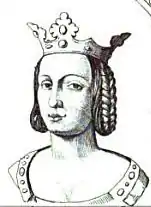Adelaide of Aquitaine
Adbelahide, Adele, Adela or Adelaide of Aquitaine (also known as Adelaide of Poitiers; c. 945 or 952 – 1004),[1] was Queen of France by marriage to Hugh Capet, King of the Franks (c. 939 – 14 October 996). Adelaide and Hugh were the founders of the Capetian dynasty of France, which would rule France until the 18th and 19th centuries. As queen consort, Adelaide had some extent of influence over her husband's governance of France. Adelaide is typically only briefly mentioned in connection to her husband, Hugh, and her son Robert II.
| Adelaide of Aquitaine | |
|---|---|
 | |
| Queen consort of the Franks | |
| Tenure | 987–996 |
| Born | c. 945/952 |
| Died | 1004 |
| Spouse | Hugh Capet (m. 969; died 996) |
| Issue | Hedwig, Countess of Mons Robert II of France Gisèle, Countess of Ponthieu |
| House | Poitiers |
| Father | William III of Aquitaine |
| Mother | Adele of Normandy |
Life
Adelaide was the daughter of William III, Duke of Aquitaine and Adele of Normandy, daughter of Rollo of Normandy.[lower-alpha 1]
On 29 May 987, after the death of Louis V, the last Carolingian king of France, Hugh was elected the new king by an assembly of Frankish magnates at Senlis. The couple were proclaimed king and queen at Senlis and blessed at Noyon on 1 June 987. They became the founders of the Capetian dynasty of France.[3] Apparently, Hugh trusted in Adelaide's judgement and allowed her to take part in government. Hugh's recognition of Adelaide as socia et particeps nostril regni, roughly translated to "associate and participator in our kingdom", demonstrates his apparent acclaim for Adelaide.[4]
Adelaide's son Robert's tutor Gerbert of Aurillac came into conflict in the late 990's with Arnulf, the archbishop of Reims.[5] Gerbert took refuge with Otto III, the new Holy Roman emperor, and Adelaide attempted to recall the former to Reims, but Gerbert reluctantly resisted this command in a letter dated to the spring of 997, citing concerns for his personal safety and the stability of the French kingdom had he returned to challenge Arnulf for the archbishopric.[6]
Children
Adelaide and Hugh had at least three children that lived to adulthood:
- Hedwig, Countess of Mons (or Hadevide, or Avoise) (c. 969–after 1013), wife of Reginar IV, Count of Mons
- Robert II (972–1031), the future king of France. Crowned co-king in 987, in order to consolidate the new dynasty.
- Gisèle, Countess of Ponthieu (c. 970–1002), wife of Hugh I, Count of Ponthieu.
Notes
- According to Bouchard, Adelaide was not from Poitou/Aquitaine. A document from 982, used as "proof" of Adelaide's origins, indicates a sister(Adela) of William IV of Aquitaine marrying a Duke Eblo, which was later altered to state Duke Hugh Capet. Bouchard states the document seems disorganized and that both Duke Eblo and his wife Adela were already dead by 982. Bouchard therefore states Adelaide's ancestry is unknown.[2]
References
- "Women's Biography: Adelaide of Aquitaine, queen of the Franks". Epistolae: Medieval Women's Latin Letters. Archived from the original on 20 December 2016. Retrieved 7 December 2011.
- Bouchard 2001, p. 114.
- "Women's Biography: Adelaide of Aquitaine, queen of the Franks". Epistolae: Medieval Women's Latin Letters. Archived from the original on 20 December 2016. Retrieved 7 December 2011.
- Andrew W. Lewis, Royal Succession in Capetian France, Studies on Familial Order and the State (London: 1981), quoted in Jim Bradbury, The Capetians: Kings of France, 987-1328. (London, UK: Hambledon Continuum, 2007), 69.
- Bradbury, Jim. The Capetians: Kings of France, 987-1328. London, UK: Hambledon Continuum, 2007, 76, 80-1.
- "A letter from Gerbert of Aurillac, archbishop of Reims (spring 997) | Epistolae". epistolae.ctl.columbia.edu. Retrieved 2020-05-11.
Sources
- Bouchard, Constance Brittain (2001). Those of My Blood: Creating Noble Families in Medieval Francia. University of Pennsylvania Press.